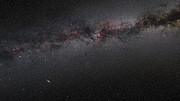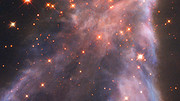Wide-field view of the centre of the Milky Way
PR Image eso1835d
The centre of the Milky Way*
Videos



Oliver Pfuhl
IR Group Secretariat

ESOcast 181 Light: Most Detailed Observations of Material Orbiting close to a Black Hole (4K UHD)

Simulation of Material Orbiting close to a Black Hole

Zooming into Sagittarius A*
Simulation of the orbits of stars around the black hole at the centre of the Milky Way
ESO’s GRAVITY instrument confirms black hole status of the Milky Way centre
ESO’s exquisitely sensitive GRAVITY
instrument has added further evidence to the long-standing assumption
that a supermassive black hole lurks in the centre of the Milky Way. New
observations show clumps of gas swirling around at about 30% of the
speed of light on a circular orbit just outside its event horizon — the
first time material has been observed orbiting close to the point of no
return, and the most detailed observations yet of material orbiting this
close to a black hole.
ESO’s GRAVITY instrument on the Very Large Telescope (VLT) Interferometer has been used by scientists from a consortium of European institutions, including ESO [1], to observe flares of infrared radiation coming from the accretion disc around Sagittarius A*,
the massive object at the heart of the Milky Way. The observed flares
provide long-awaited confirmation that the object in the centre of our
galaxy is, as has long been assumed, a supermassive black hole. The flares originate from material orbiting very close to the black hole’s event horizon — making these the most detailed observations yet of material orbiting this close to a black hole.
While some matter in the accretion disc — the belt of gas orbiting Sagittarius A* at relativistic speeds [2]
— can orbit the black hole safely, anything that gets too close is
doomed to be pulled beyond the event horizon. The closest point to a
black hole that material can orbit without being irresistibly drawn
inwards by the immense mass is known as the innermost stable orbit, and
it is from here that the observed flares originate.
"It’s mind-boggling to actually witness material orbiting a massive black hole at 30% of the speed of light," marvelled Oliver Pfuhl, a scientist at the MPE. "GRAVITY’s tremendous sensitivity has allowed us to observe the accretion processes in real time in unprecedented detail."
These measurements were only possible thanks to international collaboration and state-of-the-art instrumentation [3].
The GRAVITY instrument which made this work possible combines the light
from four telescopes of ESO’s VLT to create a virtual super-telescope
130 metres in diameter, and has already been used to probe the nature of
Sagittarius A*.
Earlier this year, GRAVITY and SINFONI, another instrument on the VLT, allowed the same team to accurately measure the close fly-by of the star S2
as it passed through the extreme gravitational field near Sagittarius
A*, and for the first time revealed the effects predicted by Einstein’s
general relativity in such an extreme environment. During S2’s close
fly-by, strong infrared emission was also observed.
"We were closely monitoring S2, and of course we always keep an eye on Sagittarius A*," explained Pfuhl. "During
our observations, we were lucky enough to notice three bright flares
from around the black hole — it was a lucky coincidence!"
This emission, from highly energetic electrons very close
to the black hole, was visible as three prominent bright flares, and
exactly matches theoretical predictions for hot spots orbiting close to a
black hole of four million solar masses [4]. The flares are thought to originate from magnetic interactions in the very hot gas orbiting very close to Sagittarius A*.
Reinhard Genzel, of the Max Planck Institute for Extraterrestrial Physics (MPE) in Garching, Germany, who led the study, explained: "This always was one of our dream projects but we did not dare to hope that it would become possible so soon." Referring to the long-standing assumption that Sagittarius A* is a supermassive black hole, Genzel concluded that "the result is a resounding confirmation of the massive black hole paradigm."
Notes
[1] This research was undertaken by scientists from the Max Planck Institute for Extraterrestrial Physics(MPE), the Observatoire de Paris, the Université Grenoble Alpes, CNRS, the Max Planck Institute for Astronomy, the University of Cologne, the Portuguese CENTRA – Centro de Astrofisica e Gravitação and ESO.
[2] Relativistic speeds are those which are so great that the effects of Einstein’s Theory of Relativity
become significant. In the case of the accretion disc around
Sagittarius A*, the gas is moving at roughly 30% of the speed of light.
[3] GRAVITY was developed by
a collaboration consisting of the Max Planck Institute for
Extraterrestrial Physics (Germany), LESIA of Paris
Observatory–PSL/CNRS/Sorbonne Université/Univ. Paris Diderot and IPAG of
Université Grenoble Alpes/CNRS (France), the Max Planck Institute for
Astronomy (Germany), the University of Cologne (Germany), the
CENTRA–Centro de Astrofísica e Gravitação (Portugal) and ESO.
[4] The solar mass is a unit used in astronomy. It is equal to the mass of our closest star, the Sun, and has a value of 1.989 × 1030 kg. This means that Sgr A* has a mass 1.3 trillion times greater than the Earth.
More Information
This research was presented in a paper entitled "Detection
of Orbital Motions Near the Last Stable Circular Orbit of the Massive
Black Hole SgrA*", by the GRAVITY Collaboration, published in the
journal Astronomy & Astrophysics on 31 October 2018.
The GRAVITY Collaboration team is composed of: R. Abuter
(ESO, Garching, Germany), A. Amorim (Universidade de Lisboa, Lisbon,
Portugal), M. Bauböck (Max Planck Institute for Extraterrestrial
Physics, Garching, Germany [MPE]), J.P. Berger (Univ. Grenoble Alpes,
CNRS, IPAG, Grenoble, France [IPAG]; ESO, Garching, Germany), H. Bonnet
(ESO, Garching, Germany), W. Brandner (Max Planck Institute for
Astronomy, Heidelberg, Germany [MPIA]), Y. Clénet (LESIA, Observatoire
de Paris, PSL Research University, CNRS, Sorbonne Universités, UPMC
Univ. Paris 06, Univ. Paris Diderot, Meudon, France [LESIA])), V. Coudé
du Foresto (LESIA), P. T. de Zeeuw (Sterrewacht Leiden, Leiden
University, Leiden, The Netherlands; MPE), C. Deen (MPE), J. Dexter
(MPE), G. Duvert (IPAG), A. Eckart (University of Cologne, Cologne,
Germany; Max Planck Institute for Radio Astronomy, Bonn, Germany), F.
Eisenhauer (MPE), N.M. Förster Schreiber (MPE), P. Garcia (Universidade
do Porto, Porto, Portugal; Universidade de Lisboa Lisboa, Portugal), F.
Gao (MPE), E. Gendron (LESIA), R. Genzel (MPE; University of California,
Berkeley, California, USA), S. Gillessen (MPE), P. Guajardo (ESO,
Santiago, Chile), M. Habibi (MPE), X. Haubois (ESO, Santiago, Chile),
Th. Henning (MPIA), S. Hippler (MPIA), M. Horrobin (University of
Cologne, Cologne, Germany), A. Huber (MPIA), A. Jimenez Rosales (MPE),
L. Jocou (IPAG), P. Kervella (LESIA; MPIA), S. Lacour (LESIA), V.
Lapeyrère (LESIA), B. Lazareff (IPAG), J.-B. Le Bouquin (IPAG), P. Léna
(LESIA), M. Lippa (MPE), T. Ott (MPE), J. Panduro (MPIA), T. Paumard
(LESIA), K. Perraut (IPAG), G. Perrin (LESIA), O. Pfuhl (MPE), P.M.
Plewa (MPE), S. Rabien (MPE), G. Rodríguez-Coira (LESIA), G. Rousset
(LESIA), A. Sternberg (School of Physics and Astronomy, Tel Aviv
University, Tel Aviv, Israel, Center for Computational Astrophysics,
Flatiron Institute, New York, USA), O. Straub (LESIA), C. Straubmeier
(University of Cologne, Cologne, Germany), E. Sturm (MPE), L.J. Tacconi
(MPE), F. Vincent (LESIA), S. von Fellenberg (MPE), I. Waisberg (MPE),
F. Widmann (MPE), E. Wieprecht (MPE), E. Wiezorrek (MPE), J. Woillez
(ESO, Garching, Germany), S. Yazici (MPE; University of Cologne,
Cologne, Germany).
ESO is the foremost intergovernmental astronomy
organisation in Europe and the world’s most productive ground-based
astronomical observatory by far. It has 16 Member States: Austria,
Belgium, the Czech Republic, Denmark, France, Finland, Germany, Ireland,
Italy, the Netherlands, Poland, Portugal, Spain, Sweden, Switzerland
and the United Kingdom, along with the host state of Chile and with
Australia as a Strategic Partner. ESO carries out an ambitious programme
focused on the design, construction and operation of powerful
ground-based observing facilities enabling astronomers to make important
scientific discoveries. ESO also plays a leading role in promoting and
organising cooperation in astronomical research. ESO operates three
unique world-class observing sites in Chile: La Silla, Paranal and
Chajnantor. At Paranal, ESO operates the Very Large Telescope and its
world-leading Very Large Telescope Interferometer as well as two survey
telescopes, VISTA working in the infrared and the visible-light VLT
Survey Telescope. ESO is also a major partner in two facilities on
Chajnantor, APEX and ALMA, the largest astronomical project in
existence. And on Cerro Armazones, close to Paranal, ESO is building the
39-metre Extremely Large Telescope, the ELT, which will become "the
world’s biggest eye on the sky".
Links
Contacts
Oliver Pfuhl
Max Planck Institute for Extraterrestrial Physics
Garching bei München, Germany
Tel: +49 89 30 000 3295
Email: pfuhl@mpe.mpg.de
Jason Dexter
Max Planck Institute for Extraterrestrial Physics
Garching bei München, Germany
Tel: +49 89 30 000 3324
Email: jdexter@mpe.mpg.de
Thibaut Paumard
CNRS Researcher
Observatoire de Paris, France
Tel: +33 145 077 5451
Email: thibaut.paumard@obspm.fr
Xavier Haubois
ESO Astronomer
Santiago, Chile
Tel: +56 2 2463 3055
Email: xhaubois@eso.org
IR Group Secretariat
Max Planck Institute for Extraterrestrial Physics
Garching bei München, Germany
Tel: +49 89 30000 3880
Email: ir-office@mpe.mpg.de
Source: ESO/News






























